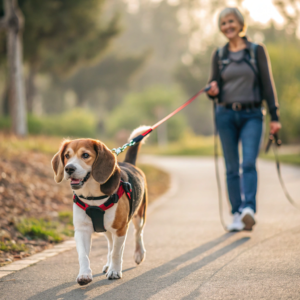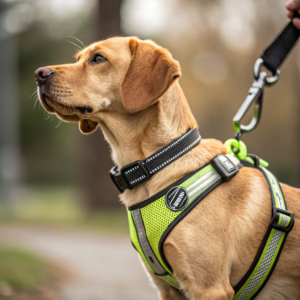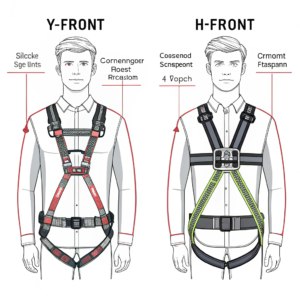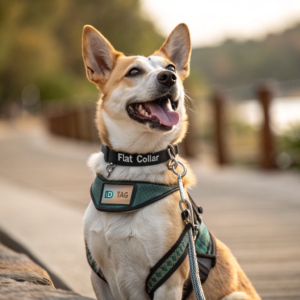Which Pet Harnesses, Leashes, & Collars Actually Work for Problem Pullers?
Your arms ache, your shoulders burn, and your walks have become a constant battle of wills. Your dog’s pulling has transformed what should be enjoyable outings into stressful ordeals for both of you.
**The most effective anti-pulling equipment includes The most effective anti-pulling equipment includes front-attachment harnesses like the PetSafe Easy Walk or 2 Hounds Freedom No-Pull, head halters like the Gentle Leader, and double-ended leashes1 that connect to both front and back attachment points, providing directional control without causing discomfort

After years of working with dogs of all sizes and testing countless combinations of harnesses, collars, and leashes, I’ve discovered what actually works versus what just looks good. Let me share the practical solutions that have transformed walks for both me and countless frustrated dog owners I’ve helped.
What Is the Best Collar and Leash for a Dog That Pulls?
Every walk has become a dreaded tug-of-war. Your arm feels like it might detach from its socket, and your dog seems completely oblivious to your struggles. You’re desperate for something—anything—that will make walks enjoyable again.
For strong pullers, the most effective combination is a front-attachment harness paired with a 5-6 foot For strong pullers, the most effective combination is a front-attachment harness1 paired with a 5-6 foot double-ended leash that connects to both chest and back attachment points

When it comes to managing a dog that pulls, the right equipment makes all the difference between dreading walks and actually enjoying them. Through years of training dogs with pulling issues, I’ve found that the collar-leash combination is actually less important than understanding the physics and psychology behind effective walking systems.
Traditional flat collars, while fine for ID tags and light control with well-trained dogs, present serious problems for pullers. When a dog pulls against a collar, the pressure goes directly against the trachea, thyroid gland, and cervical vertebrae. This not only causes physical discomfort but can lead to serious health issues like tracheal collapse, increased intraocular pressure, and even thyroid damage over time.
This is why I almost never recommend any type of collar as the primary walking tool for a dedicated puller. Even "training collars" like slip collars, choke chains, or prong collars rely on discomfort or pain to discourage pulling—a methodology that can damage your relationship with your dog and potentially cause physical harm.
Instead, the foundation of an effective anti-pulling system starts with the right harness—specifically one with a front attachment point. But the leash you pair with this harness is equally crucial. Let me break down the most effective combinations:
Optimal Leash-Harness Combinations for Pullers
| Harness Type | Ideal Leash Type | Why This Works |
|---|---|---|
| Front-clip harness | 5-6 ft double-ended leash | Connects to both front and back for balanced control |
| Y-shaped front-clip harness | 4-6 ft padded handle leash | Provides quick control in unpredictable situations |
| Dual-clip harness | Adjustable-length training leash | Allows transition between training and maintenance modes |
| Head halter | Lightweight, shock-absorbing leash | Prevents sudden jerking that could injure the neck |
The double-ended leash deserves special attention as it’s transformed my approach to handling strong pullers. By attaching one end to the front chest clip and the other to the back ring, you create a steering system that gives you mechanical advantage without harsh corrections. When the dog pulls, the front connection turns them slightly toward you, while the When the dog pulls, the front connection1 turns them slightly toward you, while the back connection maintains overall directional control.
Material matters too—I’ve found that soft, tubular nylon or climbing rope-style leashes prevent the hand burns that can come from a pulling dog with a standard flat leash. For extremely strong dogs, look for leashes with built-in shock-absorbing sections, like the Ruffwear Roamer or EzyDog CUJO.
Leash length is another consideration often overlooked. While retractable leashes are popular, they’re actually counterproductive for pullers as they teach dogs that pulling extends their range. A fixed-length leash of 5-6 feet provides enough freedom while maintaining control. For training purposes, an adjustable-length leash that can be shortened during high-distraction scenarios and lengthened when the dog is calmer proves invaluable.
Handle design might seem like a minor detail, but when you’re managing a strong puller, it becomes crucial for your comfort and safety. Padded handles with proper ergonomics prevent the leash from cutting into your hand, while traffic handles (secondary handles closer to the dog) provide immediate control in emergency situations.
I learned this lesson the hard way when walking a client’s 90-pound Rottweiler who spotted a squirrel. The standard loop handle slipped right through my fingers, but having implemented a traffic handle after that incident saved me from similar experiences countless times.
Remember that even the best equipment is a management tool, not a complete solution. Pairing these tools with positive reinforcement training—rewarding your dog for walking without tension on the leash—creates lasting behavior change. The equipment gives you control during the learning process, but consistent training creates a dog that chooses not to pull.
What Is the Best Harness for a Dog to Walk on a Leash?
You’ve tried collar after collar with no improvement in your dog’s pulling. Now you’re considering a harness, but the overwhelming options leave you confused. You need to know which harness actually works for enjoyable walks, not just what’s trending or looks good.
The best walking harnesses feature front chest attachment points, adjustable straps for proper fit, padded contact points to prevent chafing, and Y-shaped chest designs that don’t restrict shoulder movement, with top options including the Blue-9 Balance, PetSafe Easy Walk, and Ruffwear Front Range.

Having personally fitted hundreds of dogs with various harness styles, I’ve learned that harness effectiveness varies dramatically based on design, fit, and your specific dog’s build and behavior. Not all harnesses are created equal, and many popular styles can actually make pulling worse.
The fundamental difference between effective walking harnesses and problematic ones comes down to attachment point and The fundamental difference between effective walking harnesses and problematic ones comes down to attachment point1 and pressure distribution
The most effective walking harnesses share several key features that work together to discourage pulling while maintaining your dog’s comfort:
Key Features of Effective Walking Harnesses
| Feature | Function | Example Products |
|---|---|---|
| Front chest attachment | Redirects forward momentum | PetSafe Easy Walk, 2 Hounds Freedom No-Pull |
| Y-shaped chest design | Preserves natural shoulder motion | Blue-9 Balance, Ruffwear Front Range |
| Multiple adjustment points | Creates custom fit for diverse body types | Perfect Fit (8 points), Blue-9 Balance (9 points) |
| Padded contact points | Prevents chafing and improves comfort | Kurgo Journey, Ruffwear Front Range |
| Dual attachment options | Allows training progression | 2 Hounds Freedom No-Pull, Rabbitgoo No-Pull |
The chest strap configuration is particularly important yet often overlooked. Harnesses with straps that form a Y-shape on the chest allow for free shoulder movement, while those with horizontal straps across the chest (H-style) can restrict the shoulder’s natural extension during walking. This restriction not only creates discomfort but can potentially alter your dog’s gait over time.
After trying dozens of harnesses on my own dogs and clients’ dogs, I’ve found the Blue-9 Balance Harness to be exceptionally effective across different breeds and body types. Its nine adjustment points accommodate everything from deep-chested Greyhounds to barrel-chested Bulldogs, and the minimalist design prevents the overheating and chafing that can occur with heavily padded models.
For dogs with sensitive skin or thin fur, the Perfect Fit modular harness offers targeted padding exactly where needed, while the Ruffwear Front Range provides excellent overall padding for active dogs who wear their harness for extended periods.
Proper fit is absolutely crucial—a poorly fitted "good" harness is worse than a well-fitted basic harness. When fitting a harness:
- You should be able to slip two fingers between the harness and your dog’s body at any point
- The chest attachment should sit at the center of the breastbone, not sliding to either side
- The side straps should not rub against the armpits when walking
- Back straps should not put pressure on the spine or slide side to side
One mistake I frequently see is owners selecting harnesses based primarily on padding or appearance rather than structural design. While comfort matters, the biomechanical function of the harness—how it works with your dog’s body during movement—is far more important for both effectiveness and long-term comfort.
It’s worth noting that some dogs require an acclimation period when switching to a front-clip harness. If your dog freezes or shows discomfort initially, use positive association through treats and praise while fitting the harness, and keep initial walks short until they adjust to the new sensation.
For particularly clever escape artists who back out of standard harnesses, consider models with additional security features like the Ruffwear Flagline or Web Master, which include an extra strap behind the ribcage. These provide escape prevention without compromising the walking mechanics that make front-clip harnesses effective.
Can a Dog Wear a Collar and a Harness at the Same Time?
Your dog’s harness works great for walks, but you’re concerned about identification when they’re not wearing it. You wonder if using both a collar and harness simultaneously is uncomfortable, confusing, or even dangerous for your pup.
Yes, most dogs can safely wear both a Yes, most dogs can safely wear both a flat collar and harness1 simultaneously, with the collar holding ID tags and the harness1 being used for leash attachment during walks

This question comes up frequently in my training sessions, and I’m always glad when owners consider it. The practice of wearing both a collar and harness simultaneously is not only common but often recommended by trainers and veterinarians for several practical reasons.
First, let’s address the safety concerns. When properly fitted, a flat collar and harness can be worn together without causing discomfort or restriction. The key is ensuring that both pieces of equipment are correctly sized and adjusted. The collar should be snug enough that it won’t slip over the dog’s head but loose enough to allow you to easily slip two fingers underneath it. The harness should be adjusted according to the manufacturer’s guidelines, generally allowing that same two-finger gap between the straps and your dog’s body.
The dual-equipment approach creates a practical system that serves different functions:
Functions of Collar and Harness When Worn Together
| Equipment | Primary Function | Secondary Functions |
|---|---|---|
| Flat Collar | ID tag holder | Visual indication dog has an owner; backup restraint in emergency |
| Harness | Walking control point | Distribution of leash pressure; additional handling options |
When using both, there are some important guidelines to follow:
-
Never attach a leash to both the collar and harness simultaneously. This creates conflicting pressure points and can cause injury, especially if your dog lunges suddenly.
-
Ensure the collar sits higher on the neck than the harness straps. This prevents uncomfortable rubbing or chafing where the equipment might otherwise overlap.
-
Remove any dangling tags from the collar that might get caught in the harness. Consider using a flat tag that attaches directly to the collar or a tag silencer that prevents jingling and catching.
-
Regularly check the fit of both pieces as your dog’s weight, coat condition, or muscle tone changes. What fits perfectly in winter might be too loose or tight when your dog sheds their coat in spring.
I’ve found this dual system particularly valuable for certain types of dogs:
Dogs That Benefit Most from the Collar-Harness Combination
| Dog Type | Specific Benefit |
|---|---|
| Escape artists | Provides backup identification if they slip out of either piece |
| Water-loving breeds | Collar can remain on for ID while harness is removed for swimming |
| Dogs in training | Allows clear distinction between training sessions and regular wear |
| Senior dogs | Provides multiple gentle lifting points for assistance |
One of my clients with an elderly Labrador found that having both a collar and a harness gave them different support options when helping their dog navigate stairs or get into the car. The harness provided better full-body support, while the collar offered a quick stabilization point when needed.
For dogs that participate in various activities, this system also offers flexibility. When my Border Collie and I go hiking, she wears both her harness and her collar. During active hiking, the leash attaches to her harness for better control on narrow trails. When we reach a rest area where she can settle down, I can remove the harness for her comfort while maintaining identification and control through her collar.
There are, however, some exceptions where wearing both simultaneously might not be ideal:
- Dogs with very short necks (like Pugs or Bulldogs) where space is limited
- Dogs with sensitive skin conditions that might be aggravated by multiple contact points
- Puppies still growing rapidly who need frequent size adjustments
- Dogs who show stress or discomfort with multiple pieces of equipment
For these dogs, alternatives might include:
- Collars with built-in handles for occasional control
- Harnesses with integrated ID tag holders
- Breakaway collars that stay on full-time with harnesses used only for walks
- Embroidered collars or harnesses with contact information directly on the equipment
One valuable tip I share with all my clients: regardless of your equipment choice, make sure your dog’s identification is redundant. This means microchipping in addition to visible ID tags, and potentially GPS trackers for dogs prone to wandering. The collar-harness combination supports this redundancy principle by providing multiple places to attach identification.
Conclusion
Finding the right walking equipment combination for your dog involves matching their specific needs with appropriate tools—front-attachment harnesses paired with double-ended leashes work best for strong pullers, while Y-front harnesses with proper adjustment points provide comfort and control for daily walks. Many dogs benefit from wearing both a flat collar for ID and a harness for leash attachment, creating a system that prioritizes both safety and comfort. Remember that even the best equipment works better when combined with consistent positive reinforcement training.
-
Discover why a harness can be a better option for leash attachment and overall dog comfort.
and harness simultaneously, with the collar holding ID tags and the harness being used for leash attachment during walks. This provides constant identification while avoiding the neck pressure problems caused by attaching a leash to the collar. ↩ ↩ ↩ ↩ ↩ ↩

